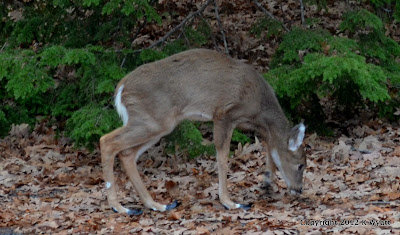Julep & the Super-hero Quilt
She looks so regal sitting there. I hate to tell her this is
going to Cole who is our California grandson.
My next project will be for Cole's sister Kaitlyn.
I'm working on a Hello Kitty quilt top for her.
Julep
Derby said...
She may be queen of the quilt but I'm king
of the warm blankets from the dryer.
Derby Sleeps
He is such a sweetie and so attached to me.
Deer Alert ... Deer Alert!
Snacking along the way.
Our 'resident' deer.
I could tell this deer was walking funny in the woods the
other day. She tends to stay around our house which drives
the westies crazy. Now I know why - look closely at
her hoofs ... they are long and starting to curl up.
Deer can sometimes grow hooves that are much longer than
normal.
Long hooves in deer is not common, and it’s not something
most hunters will see
in the field. This condition is referred
to as foundering and the
term comes from
the word “floundering” because under extreme
conditions the
animal appears to be floundering
around as it walks. From reviewing the
literature,
there appears to be three main reasons for long
hoof growth in
deer, but all are related to diet.
A deer that exhibits foundering is taking in way
too many
carbohydrates. Either this is a problem directly
related to the forage that the
animal is eating
or it has to do with the way the deer is processing its food.
More often than not, it has to do with what the deer is eating.
A diet high in
corn or protein pellets contributes to foundering.
Corn, of course, is
primarily carbohydrates.
Hoof tissue is very similar to antler tissue.
If you are
feeding protein to grow larger bodied
deer and larger antlers then you are also
feeding to
grow deer with longer hooves. Foundering is almost always
the result
of a deer consuming too many carbohydrates
in the diet too fast. The result is
a buildup of acid in the rumen,
which kills the bacteria that digest
carbohydrates.
This action then results in an increasing pH in the blood
that
can hurt or possibly even kill the deer from acidosis.
White-tailed deer than have foundered long hooves
will often
walk on the backs of their hooves because
the acid buildup agitates the growth
plate in their hooves.
As a result of the deer attempting to ease the pain,
the
hooves grow longer than normal because the
hooves do not have proper contact
with the ground.
Without proper contact, the hooves do not wear down.
This
problem can be exacerbated on ”soft” soils because
hoof wear is already
decreased in these areas.
... and we learn something new each day ...
Wishing you a happy holiday season.













We love all your sewing, you are very talented. That was interesting about the deer. Gout for animals. Have a super Sunday.
ReplyDeleteBest wishes Molly.
I think you are going to have a hard time getting that quilt away from Julep. Derby looks adorable cuddled up in his warm blanket.
ReplyDeleteThat's very interesting about the deer.
Hey, I saw my first deer last year. They're PAWSOME!
ReplyDelete